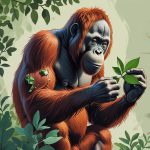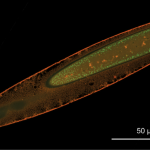Move over, humans—chimpanzees may be just as caring and clever when it comes to healing. A fascinating new study from the Budongo Forest Reserve in Uganda shows wild chimpanzees performing self-directed and prosocial wound care using leaves, tools, and social support.
These acts go far beyond simple grooming. The chimpanzees were seen:
- Treating wounds with crushed leaves
- Using tools to clean snare injuries
- Helping other chimpanzees clean and protect their wounds
This research provides some of the most compelling evidence yet of self-medication and empathetic care in wild animals.
Chimpanzee Self-Medication in Action
In the study, chimpanzees in the Sonso and Waibira communities were observed:
- Chewing medicinal leaves and applying the green froth to open wounds
- Using sticks and natural tools to remove thorns and parasites
- Targeting specific plants known for anti-inflammatory or antiseptic properties
Most of these actions occurred without any human intervention—suggesting innate or culturally learned behaviors.
Prosocial Healing: Helping Others
One of the most remarkable findings was chimpanzees helping others tend to wounds—a rare case of documented prosocial first aid in wild animals.
Examples included:
- Caregivers gently applying plant material to another’s wound
- Cleaning injuries sustained from snare traps
- Helping kin and even non-kin individuals, pointing to broader social empathy
These behaviors blur the line between instinct and intentional care, suggesting chimpanzees may share cognitive building blocks of compassion and health awareness.
The Role of Snare Injuries and Hygiene
Many chimpanzees in Budongo face debilitating snare wire injuries, which can cause deep lacerations or even loss of digits. The researchers observed that:
- Chimps used tools to remove or manage snare injuries
- Younger individuals imitated elders in wound care rituals
- Hygiene-focused behaviors like rubbing leaves or bark were targeted to specific areas (e.g., hands, feet)
Such actions imply an understanding of cause, effect, and remedy—an advanced level of problem-solving rarely seen outside humans.
Why This Matters
This study has deep implications for:
Animal cognition – Chimpanzees may possess elements of empathy, health awareness, and intentional caregiving
Conservation ethics – Recognizing the intelligence and culture of wild animals strengthens the case for ethical protection
Biomedicine – Chimp behavior may point us to new plant-based remedies used traditionally by wild animals
Human evolution – These behaviors could mirror early medicinal practices in ancestral humans
Future Questions
- Are these behaviors taught culturally or individually discovered?
- Can we map the pharmacological properties of the plants used?
- Will such behaviors be observed in other great ape populations?
Further research may help us understand how empathy and healthcare evolved not just in humans—but across species.
Conclusion
The Budongo chimpanzees aren’t just survivors—they’re healers. This study provides compelling evidence that wild apes can:
- Self-medicate with plants
- Use tools for hygiene
- Help each other heal wounds with care and intention
As science continues to peel back the layers of animal intelligence, one thing becomes clear: compassion and self-care may be more universal than we think.
Reference
Freymann, E., Hobaiter, C., Huffman, M. A., Klein, H., Muhumuza, G., Reynolds, V., … & Carvalho, S. (2025). Self-directed and prosocial wound care, snare removal, and hygiene behaviors amongst the Budongo chimpanzees. Frontiers in Ecology and Evolution, 13, 1540922. https://doi.org/10.3389/fevo.2025.1540922







